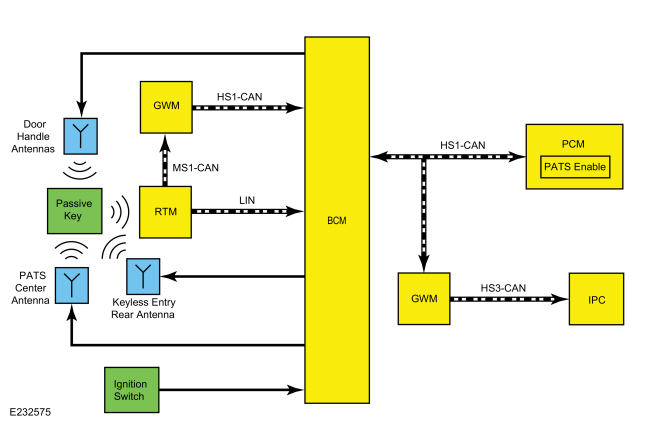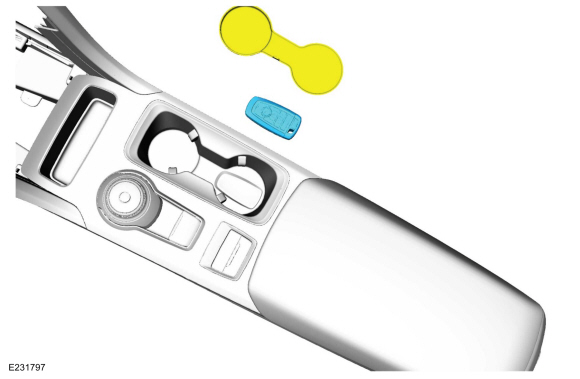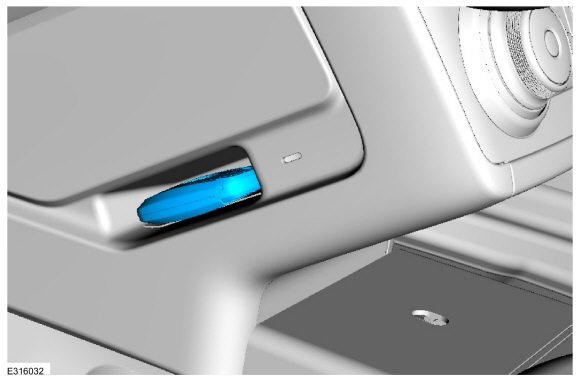Ford Fusion: Passive Anti-Theft System (PATS) / Passive Anti-Theft System (PATS) - System Operation and Component Description. Description and Operation
System Operation
System Diagram

| Item | Description |
|---|---|
| 1 | BCM |
| 2 | IPC |
| 3 | Passive Key |
| 4 | RTM |
| 5 | GWM |
| 6 | GWM |
| 7 | PATS Center Antenna |
| 8 | Keyless Entry Rear Antenna |
| 9 | Ignition Switch |
| 10 | Door Handle Antennas |
| 11 | PATS Enable |
| 12 | PCM |
Network Message Chart
BCM Network Input Messages
| Broadcast Message | Originating Module | Message Purpose |
|---|---|---|
| RKE data | RTM | The RTM sends the BCM programmed passive key information. |
| PATS start request target data | PCM/ SOBDMC | The PCM/ SOBDMC sends the BCM a challenge request for a valid ID. |
PCM/ SOBDMC Network Input Messages
| Broadcast Message | Originating Module | Message Purpose |
|---|---|---|
| PATS control command | BCM | The response from the BCM supplying the PCM/ SOBDMC challenge ID. If the BCM ID response is incorrect, then PATS prevents the vehicle from starting. |
IPC Network Input Messages
| Broadcast Message | Originating Module | Message Purpose |
|---|---|---|
| Vehicle mode | BCM | Used by the IPC to display No Key Detected when the START/STOP button is pressed and no programmed key is detected within the vehicle. |
PATS
The PATS function is controlled by the BCM and the PCM/ SOBDMC.
When the START/STOP button is pressed, a voltage signal is sent to the BCM. When the BCM detects the START/STOP button is pressed, it begins the key initialization sequence by activating the PATS center antenna, the keyless entry rear antenna and both exterior door handle keyless entry antennas. Each antenna transmits a low frequency signal with an approximate range of 1 m (3 ft). The passive key activates if it is within range of the antennas. The BCM is able to determine the passive key location (inside or outside the vehicle) based on the input from the antennas.
When the passive key activates, it sends the PATS identification code to the RTM via a high frequency signal. The RTM interprets the high frequency signal from the passive key and sends the information to the BCM over the LIN-based circuit.
If a programmed passive key is detected inside the vehicle, the BCM transitions the ignition out of off.
When the ignition transitions out of off and the modules initialize and the PCM/ SOBDMC sends a challenge request to the BCM. The BCM replies and if the correct identification is received, the PATS disables and allows the vehicle to start. If the PATS prevents the vehicle from starting, a DTC sets in one of the modules.
The PATS and the RKE system share operation of several components including the passive keys, the BCM and the RTM.
If there is a concern with either of these components, the PATS and the RKE system are both affected.
In the event of a no start, place a programmed passive key in the backup location to allow the vehicle to start. The PATS center antenna activates the passive key when the START/STOP button is pressed in the event the battery is depleted within the passive key.
NOTE: If available as a selection on the scan tool, the passive start feature is a programmable parameter and can be enabled/disabled. If the feature is disabled, the features to passively enter and start the vehicle are inoperative. To start the vehicle, the passive key must be placed in the backup starting location.
The BCM controls the ignition modes and, in conjunction with the PCM/ SOBDMC, controls the PATS.
For information on ignition states,
Refer to: Steering Wheel and Column Electrical Components - System Operation and Component Description (211-05 Steering Wheel and Column Electrical Components, Description and Operation).
PATS Parameter Identifications (PIDs)
In conjunction with Diagnostic Trouble Codes (DTCs), the PATS Parameter Identifications (PIDs) are a useful tool when diagnosing PATS concerns.
BCM PID Chart
| Acronym | Name | Description |
|---|---|---|
| KEYS_PROGMD | Number of ignition key codes supported | Displays the number of keys currently programmed into the BCM. |
| MIN_KEYS_RQD | Minimum number of keys required | Minimum number of programmed keys required. This PID always reads 2. |
PCM/ SOBDMC PID Chart
| Acronym | Name | Description |
|---|---|---|
| PATSENABL | Vehicle enable status | Indicates if PATS allows the vehicle to be driven. Must read enabled for the vehicle to be driven. |
Backup Starting
NOTE: There are certain areas within the vehicle where the passive key may not be detected and the message center displays No Key Detected. If the passive key is in the far outside edges of the interior (such as in a door map pocket or above a sun visor), it may not be detected. Move the passive key to a different location and try to turn the ignition on.
When the BCM does not detect a valid programmed passive key in the passenger compartment, the No Key Detected message displays in the message center when the START/STOP button is pressed.
In the event of one of these failures, place a programmed passive key in the backup location to allow the vehicle to start. When the START/STOP button is pressed, the center PATS antenna activates the passive key and the identification code is sent to the BCM. The passive key must be oriented correctly in the backup starting location.
Passive Key Backup Starting Location Without Police Package

Passive Key Backup Starting Location With Police Package

No Key Detected Message
NOTE: Some brands/types of mobile phone or laptop computer chargers may cause interference that could lead to a PATS concern if the passive key is within close proximity of the charger. If a concern is observed, move the passive key away from the charger and attempt to turn the ignition on.
There are 2 scenarios in which the No Key Detected message displays in the message center.
The first is when the ignition is off, the START/STOP button is pressed and a programmed passive key is not detected inside the vehicle. If a component failure (such as a depleted passive key battery or RTM failure) is causing the No Key Detected message to display, the backup starting method can be used.
The second scenario is when the ignition is ON, the driver exits the vehicle with the programmed passive key and closes the door.
The BCM activates the center PATS antenna, the keyless entry rear antenna and both exterior door handle keyless entry antennas to search the inside of the vehicle for a passive key any time a door or the luggage compartment lid is opened and then closed with the vehicle running and the first times each drive cycle the vehicle speed exceeds 15 km/h (9 mph). The No Key Detected message displays in the message center and the horn chirps twice when the ignition is on and a passive key is no longer detected inside the vehicle.
This strategy deters the passive key from being separated from a vehicle with the ignition ON. If a passive key is no longer in the vehicle, the ignition remains on and the vehicle continues to operate. When the START/STOP button is pressed to turn the ignition off, the ignition can be restarted without a passive key present inside the vehicle for approximately 20 seconds. After 20 seconds have elapsed, a passive key must be present to transition the ignition out of off.
Automatic Engine Idle Shutdown
The automatic engine idle shutdown feature monitors the state of the vehicle to determine when the engine is powered with no user interaction for approximately 30 minutes. Approximately 30 seconds prior to the shutdown, a message displays in the message center to inform the operator a vehicle shutdown is imminent. This includes shutting down the engine and turning the ignition off. When the shutdown occurs, press the brake and START/STOP button to re-start the vehicle (a valid programmed passive key is required).
The conditions required to begin the automatic engine idle shutdown feature are:
-
power pack enabled
- engine running (non-hybrid vehicles)
- engine running or auto stop mode active (hybrid vehicles)
- brake pedal not pressed
- accelerator pedal not pressed
- remote start not active
- transmission in P (park) or N (neutral)
- diagnostic scan tool not connected to the vehicle
Once these conditions are met, a time-out starts. When the time-out period ends and none of the listed conditions changed, the automatic engine idle shutdown event occurs.
Component Description
Passive Key
NOTE: Some brands/types of mobile phone or laptop computer chargers may cause interference that could lead to a PATS concern if the passive key is within close proximity of the charger. If a concern is observed, move the passive key away from the charger and attempt to turn the ignition on.
The passive key incorporates both the PATS and the RKE transmitter functions in a single device. The passive key must be located inside the vehicle for the ignition to transition out of off and on the outside for keyless entry features. During key programming procedures, the PATS and the RKE transmitter of the passive key are both programmed into the BCM. The vehicle accepts programming of up to 4 passive keys.
The passive key receives the low frequency signals from the PATS center antenna, the exterior door handle antennas and the keyless entry rear antenna. When the passive key is activated by one of the low frequency signals, it sends out a high frequency signal that is received by the RTM. The passive key must be located inside the vehicle for the ignition to transition out of OFF and outside the vehicle for passive entry features.
The passive key also contains a removable key blade that unlocks the driver door in the event of an electrical failure (such as a drained battery). For battery replacement instructions, refer to the Owner's Manual.
For backup starting, refer to Backup Starting in this section.
PATS Center Antenna
NOTE: Some brands/types of mobile phone or laptop computer chargers may cause interference that could lead to a PATS concern if the passive key is within a few inches of the charger and the No Key Detected message displays in the message center. If a concern is observed, move the passive key away from the charger and attempt to transition the ignition on.
The PATS center antenna wired to the BCM. When activated by the BCM, it transmits a low frequency signal that activates a passive key. This antenna serves a dual purpose in that it can detect a passive key in the backup starting location. The backup starting location is used to program passive keys and to detect a programmed passive key in the event the battery in the programmed passive key has failed.
A programmed passive key must be within the passenger compartment or the luggage compartment for the PATS to detect the passive key and allow the ignition to transition out of OFF.
If a passive key is placed in the far outside edges of the interior, such as above a sun visor or in a door map pocket, the vehicle can experience a PATS concern. If the passive key is located in one of these areas and there is a PATS concern, move the passive key out of the area and attempt to transition the ignition on. If the key is outside the range of the PATS center antenna and the keyless entry rear antenna when the START/STOP button is pressed, the No Key Detected message displays in the message center.
Keyless Entry Rear Antenna
NOTE: Some brands/types of mobile phone or laptop computer chargers may cause interference that could lead to a PATS concern if the passive key is within a few inches of the charger and the No Key Detected message displays in the message center. If a concern is observed, move the passive key away from the charger and attempt to transition the ignition on.
A programmed passive key must be within the passenger compartment or the luggage compartment for the PATS to detect the passive key and allow the ignition to transition out of OFF.
If a passive key is placed in the far outside edges of the interior, such as the far corners of the luggage compartment, the vehicle can experience a PATS concern. If the passive key is located in one of these areas and there is a PATS concern, move the passive key out of the area and attempt to transition the ignition on. If the key is outside the range of the keyless entry rear antenna and the center PATS antenna when the START/STOP button is pressed, the No Key Detected message displays in the message center.
Exterior Front Door Handles
The exterior door handles contain a keyless entry antenna. The antennas are wired to the BCM. When activated by the BCM, the antenna transmits a low frequency signal with an approximate range of 1 m (3 ft) to activate a passive key.
A programmed passive key must be within range for the PATS to operate.
If a passive key is placed in the far outside edges of the interior, such as the far corners of the luggage compartment, the vehicle can experience a PATS concern. If the passive key is located in one of these areas and there is a PATS concern, move the passive key out of the area and attempt to transition the ignition on. If the key is determined by the BCM to be outside the vehicle or is outside the range of the antennas within the exterior front door handles, the keyless entry rear antenna and the center PATS antenna when the START/STOP button is pressed, the No Key Detected message displays in the message center.
BCM
If the BCM is replaced, carry out the PMI process, program at least 2 keys and carry out the parameter reset procedure.
PCM/ SOBDMC
When the PCM/ SOBDMC is replaced, carry out the parameter reset procedure. There is no need to program keys if the PCM/ SOBDMC is replaced.
 Passive Anti-Theft System (PATS) - Overview. Description and Operation
Passive Anti-Theft System (PATS) - Overview. Description and Operation
Overview
The PATS
deters the vehicle from theft by preventing the vehicle from starting
unless a programmed key is detected inside the vehicle when the
START/STOP button is pressed...
 Passive Anti-Theft System (PATS). Diagnosis and Testing
Passive Anti-Theft System (PATS). Diagnosis and Testing
DTC Charts
Diagnostics in this manual assume a certain skill level and knowledge of Ford-specific diagnostic practices. REFER to: Diagnostic Methods (100-00 General Information, Description and Operation)...
Other information:
Ford Fusion 2013–2020 Service Manual: Roof Opening Panel Frame. Removal and Installation
Removal NOTE: Removal steps in this procedure may contain installation details. If replacing the roof opening panel frame, remove the air deflector. Refer to: Air Deflector (501-17 Roof Opening Panel, Removal and Installation). Fully close the roof opening panel glass...
Ford Fusion 2013–2020 Owners Manual: Bluetooth Stereo or USB
Bluetooth Stereo and USB allow you to access media that you store on your Bluetooth device or USB device such as music, audio books or podcasts. The following buttons are available for Bluetooth and USB: You can use the forward, reverse, pause or play buttons to control the audio playback...
Categories
- Manuals Home
- 2nd Generation Ford Fusion Owners Manual
- 2nd Generation Ford Fusion Service Manual
- Engine - 1.5L EcoBoost (118kW/160PS) – I4
- Cylinder Head. Removal and Installation
- Memory Function
- New on site
- Most important about car
Parallel Parking
The system detects available parallel parking spaces and steers your vehicle into the space. You control the accelerator, gearshift and brakes. The system visually and audibly guides you into a parallel parking space.
 Press the button once to search
for a parking space.
Press the button once to search
for a parking space.

.jpg)